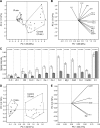Laser-induced breakdown spectroscopy (LIBS) as a novel technique for detecting bacterial infection in insects
- PMID: 30792483
- PMCID: PMC6385218
- DOI: 10.1038/s41598-019-39164-8
Laser-induced breakdown spectroscopy (LIBS) as a novel technique for detecting bacterial infection in insects
Abstract
To prevent the spread of diseases in humans, animals or plants, determining whether potential vectors are infected is crucial. For example, early detection of the citrus disease Huanglongbing, which has been a scourge on the citrus industries around the world, is a critical need. This vector-borne disease is transmitted by Diaphorina citri, the Asian citrus psyllid, which carries the putative bacterial phytopathogen, Candidatus Liberibacter asiaticus (CLas). In this investigation, we introduced Laser-Induced Breakdown Spectroscopy (LIBS) to reveal key biochemical differences between CLas-infected and non-infected psyllids. The emission spectra captured from laser ablation of CLas-infected and healthy psyllids were processed through the principal component analysis (PCA) method and compared. Thirteen peaks from seven different elements were detected in D. citri. The t-test showed that CLas-infected D. citri were deficients in zinc, iron, copper, magnesium, calcium, and nitrogen. The PCA showed that LIBS can successfully differentiate between CLas-infected and healthy D. citri by comparing their elemental profile. In this work, we demonstrated a method that allows for a fast and precise compositional microanalysis of an insect vector which can contribute to the early detection of citrus huanglongbing.
Conflict of interest statement
The authors declare no competing interests.
Figures



Similar articles
-
Distribution and Variation of Bacterial Endosymbiont and "Candidatus Liberibacter asiaticus" Titer in the Huanglongbing Insect Vector, Diaphorina citri Kuwayama.Microb Ecol. 2019 Jul;78(1):206-222. doi: 10.1007/s00248-018-1290-1. Epub 2018 Nov 24. Microb Ecol. 2019. PMID: 30474731
-
A Plant Bacterial Pathogen Manipulates Its Insect Vector's Energy Metabolism.Appl Environ Microbiol. 2017 Feb 15;83(5):e03005-16. doi: 10.1128/AEM.03005-16. Print 2017 Mar 1. Appl Environ Microbiol. 2017. PMID: 28039132 Free PMC article.
-
Infection of an Insect Vector with a Bacterial Plant Pathogen Increases Its Propensity for Dispersal.PLoS One. 2015 Jun 17;10(6):e0129373. doi: 10.1371/journal.pone.0129373. eCollection 2015. PLoS One. 2015. PMID: 26083763 Free PMC article.
-
Diaphorina citri (Hemiptera: Liviidae) Vector Competence for the Citrus Greening Pathogen 'Candidatus Liberibacter Asiaticus'.J Econ Entomol. 2015 Jun;108(3):839-48. doi: 10.1093/jee/tov038. Epub 2015 Mar 21. J Econ Entomol. 2015. PMID: 26470202 Review.
-
Progress and Obstacles in Culturing 'Candidatus Liberibacter asiaticus', the Bacterium Associated with Huanglongbing.Phytopathology. 2019 Jul;109(7):1092-1101. doi: 10.1094/PHYTO-02-19-0051-RVW. Epub 2019 Jun 3. Phytopathology. 2019. PMID: 30998129 Review.
Cited by
-
Huanglongbing as a Persistent Threat to Citriculture in Latin America.Biology (Basel). 2025 Mar 25;14(4):335. doi: 10.3390/biology14040335. Biology (Basel). 2025. PMID: 40282200 Free PMC article. Review.
-
Laser-sound: optoacoustic transduction from digital audio streams.Sci Rep. 2021 Jan 22;11(1):476. doi: 10.1038/s41598-020-78990-z. Sci Rep. 2021. PMID: 33483555 Free PMC article.
-
Hydrogen isotopes retention studies using laser and microwave induced plasma coupling.Sci Rep. 2025 Apr 12;15(1):12589. doi: 10.1038/s41598-025-96546-x. Sci Rep. 2025. PMID: 40221556 Free PMC article.
-
Visualization and accuracy improvement of soil classification using laser-induced breakdown spectroscopy with deep learning.iScience. 2023 Feb 9;26(3):106173. doi: 10.1016/j.isci.2023.106173. eCollection 2023 Mar 17. iScience. 2023. PMID: 36926652 Free PMC article.
References
-
- Jagoueix S, Bové JM, Garnier M. The phloem-limited bacterium of greening disease of citrus is a member of the α subdivision of the Proteobacteria. Int. J. Syst. Evol. Microbiol. 1994;44:379–386. - PubMed
-
- Hall DG, Richardson ML, Ammar ED, Halbert SE. Asian citrus psyllid, Diaphorina citri, vector of citrus huanglongbing disease. Entomol. Exp. App. 2013;146:207–223. doi: 10.1111/eea.12025. - DOI
-
- Meyer JM, Hoy MA. Molecular survey of endosymbionts in Florida populations of Diaphorina citri (Hemiptera: Psyllidae) and its parasitoids Tamarixia radiata (Hymenoptera: Eulophidae) and Diaphorencyrtus aligarhensis (Hymenoptera: Encyrtidae) Florida Entomol. 2008;91:294–304. doi: 10.1653/0015-4040(2008)91[294:MSOEIF]2.0.CO;2. - DOI
Publication types
MeSH terms
LinkOut - more resources
Full Text Sources
Medical

